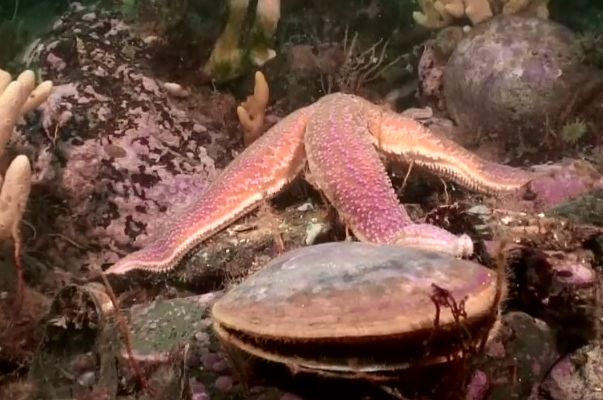The parrotfish creates a mucus cocoon around itself every night.
鹦嘴鱼每晚都在自己周围用粘液造一个茧。
This bubble protects the fish from annoying parasitic isopods—the equivalent of an underwater mosquito.
这个气泡可以保护鱼免受类似于水下蚊子等讨厌的寄生虫的侵害。
This sleeping parrotfish has a nice bubble that is doing its job.
这只沉睡的鹦嘴鱼正在用一个漂亮的泡泡保护自己。
Look closely and you can see the isopod on the bubble, like a fly on a screen door!
仔细看的话,能看到气泡上有等足动物,就像被纱门挡住的苍蝇一样!
Nearby on the nighttime reef, an octopus is out on the prowl, hunting for sleeping fish.
夜里,在珊瑚礁附近有只章鱼正在四处觅食,寻找沉睡之中的鱼。
It sticks its tentacles into the reef to startle a sleeping fish, and hopes that the fish will come out into its web of arms it has wrapped around the coral head.
它把触角伸进珊瑚礁,以惊动沉睡的鱼,希望它能伸游进章鱼包裹在珊瑚顶上的臂网里。
But how does the octopus defend itself against bigger fish and fearsome underwater photographers with bright video lights?
但是,章鱼如何保护自己免受大鱼的袭击,以及携带明亮的视频灯、吓人的水下摄影师呢?
It squirts an ink cloud. The ink cloud is a distraction to focus the predator's attention while the octopus makes a quick getaway!
它喷出一团墨水云,当章鱼快速逃离时,墨水云会分散捕食者的注意力!
On a reef in the Philippines, a tiny octopus, barely larger than a bottle cap, is hunting for a meal.
在菲律宾的一个珊瑚礁上,一只很小的章鱼正在寻找食物,它的大小和瓶盖差不多。
It's a Blue-ringed octopus, one of the most dangerous animals in the world, packing a venom 10,000 times more deadly than cyanide.
这是蓝圈章鱼,世界上最危险的一种动物,它的毒液比氰化物的致命性高一万倍。
One bite from the Blue-ringed octopus will kill a human in only minutes.
人被蓝圈章鱼咬伤后,只需几分钟就会死亡。
Reaching into cracks and holes, the octopus hunts for shrimp or small fish to eat.
章鱼把触角伸进裂缝和洞里,寻找虾或小鱼吃。
A goby boldly protects its burrow.
一只虾虎鱼勇敢地保卫自己的洞穴。
To a nearby scorpionfish, the octopus looks like a bite-sized snack.
对于待在一旁的锯鲉来说,章鱼像一口就能吃下的零食。
The octopus doesn't see the well-camouflaged scorpionfish--watching and waiting to make its move.
章鱼没看到伪装潜伏的锯鲉,这只锯鲉正盯着它,等待行动。
The scorpionfish strikes...and gets more than he bargained for.
锯鲉进攻了,它还收到了回赠。
Within only a fraction of a second, the octopus bites back, and the scorpionfish spits it out.
不到一秒钟的时间,章鱼就反咬一口,锯鲉把它吐了出来。

The scorpionfish will have a sore mouth for days, if it even survives.
如果锯鲉能活下来的话,它的嘴会痛上好几天啊。
It turns out that the blue ringed octopus does not make a very good snack after all.
事实证明,蓝圈章鱼不是一种好吃的零食。
Some animals are not blessed with spines, venom or even the ability to move quickly.
有些动物没有刺、毒液,甚至也无法快速移动。
Crabs and lobsters have a tough exoskeleton that makes them very hard to eat. As well, they have powerful claws that can pinch and crush.
螃蟹和龙虾的外骨架很硬,不容易吃。而且,它们还有强有力的爪,可以捏住东西把它压碎。
When a threat comes near, a lobster doesn't hesitate to put up those claws and use them!
威胁物出现时,龙虾会毫不犹豫地举起爪子防卫!
A hermit crab ups the defense by using a snail shell as a portable house, to provide an extra layer of protection.
一只寄居蟹用蜗牛壳作为活动房屋来加强防御,以提供额外的保护。
Some hermit crabs take it even another step further, placing venomous stinging anemones on their shell to further increase their defensive positions.
一些寄居蟹甚至更进一步,把有毒的刺海葵放在它们的壳上,增强防御工事。
This crab might be slow, but she is very hard to eat!
这只寄居蟹或许移动速度慢,但要吃到它却很难!
Even a lowly scallop has a defense.
即使是低等动物扇贝也有防卫措施。
It has no legs for walking, or fins for swimming.
它没有步行用的腿,也没有游泳用的鳍。
But when its arch enemy the sea star approaches and makes a move, the scallop opens its shells wide and claps them together, squirting a jet of water out of its mantle.
但是,当它的宿敌海星靠近并移动时,扇贝会张开贝壳,将它们拍打在一起,从外壳膜中喷出一股水。
Whelks are another predator that try to take advantage of the scallop, but they are given the squirt treatment too!
海螺是另一个捕食者,它也想占扇贝的便宜,但扇贝还是用喷水法把它打发了!
Take that, whelks!
接招吧,海螺!
No matter how vulnerable an animal in the ocean might look, you can bet that it has a strategy to survive.
不管海洋中的动物看起来多么脆弱,它都有自己的生存策略。
Spines, venom, speed, a smoke screen or even a squirt gun.
刺、毒液、速度、烟幕,甚至还有喷水枪。
There are many ways animals have learned to defend themselves in the blue world.
在蓝色世界里,动物们学会了很多保护自己的方法。











